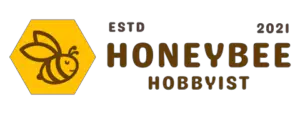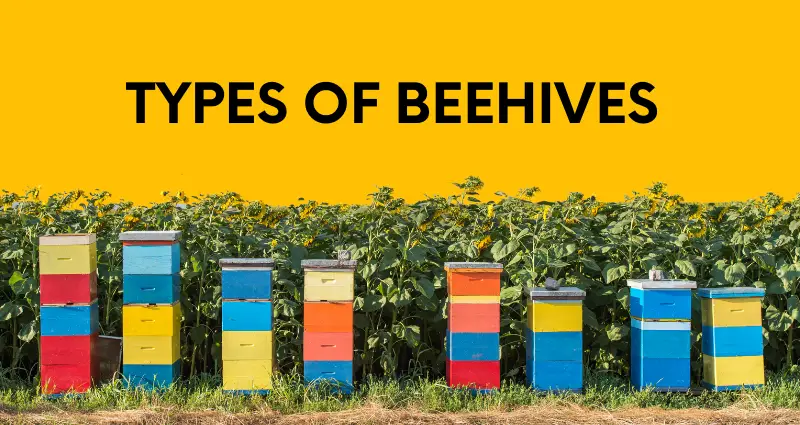The most common types of beehives are the Langstroth hive, Warré hive, and Top Bar hive because of their ease of use, low maintenance, and price point. Other types of beehives include horizontal hives, WBC hives, Apimaye hives, and the easy-to-manage Flow Hive.
Langstroth Hive
The Langstroth beehive is the most common type of beehive. Lorenzo Langstroth invented it in 1851 in the USA. Langstroth is praised for creating precise bee space gaps between the frames and the boxes. This space is crucial in all successful hive designs today. This hive is one of the most affordable options, and due to its popularity, replacement parts are easy to find.
You can easily remove the vertical hanging frames to check on production or extract honey. To increase production, many beekeepers choose to have two brood boxes.
When it comes time to check on your queen and her eggs, you’ll need to remove the top honey supers to get to the brood boxes below. Depending on your worker bees, you can expect approximately six pounds of honey per frame (sometimes more). With ten frames per box, the contents add up quickly.
Choose this hive if:
- You want a hive with removable frames that produces a lot of honey.
- Easy honey extraction is essential to you.
- You’d like to have the ability to expand.
Don’t choose this hive if:
- You can’t handle some heavy lifting.
- You prefer not to intrude on your bees when extracting honey.
Warré Hive
A French monk named Abbé Émile Warré designed this vertical foundationless top bar design in the mid-20th century. He designed it to mimic a hollow tree, providing the honey bees with a more natural setting. Instead of using frames, this hive uses bars, allowing bees to build their combs downwards vertically.
The roof is a quilt box that absorbs liquids and condensation bees produce. It also provides excellent ventilation and insulation.
Unlike the Langstroth hive, new boxes are added to the bottom of the hive, meaning that you will need to do some heavy lifting to re-order the stack of boxes.
Adding new boxes encourages the bees to create new combs instead of reusing old ones, resulting in purer honey. Eventually, you should harvest honey from the top boxes in the fall and add a new box to the bottom in the spring.
Choose this hive if:
- You don’t have or don’t want to use a queen excluder.
- You prefer a natural beekeeping environment.
- You want something low-maintenance.
Don’t choose this hive if:
- You can’t annually lift a few heavy boxes.
- You want to see what’s going on inside the hive easily.
Top Bar Hive
One of the oldest designs, the foundationless top bar hive, does not use frames. Instead, it has individual horizontal wooden bars that the bees use to build hanging combs.
This is not a good option for commercial beekeepers because top bar hives do not produce as much honey as other hives. A top bar hive produces approximately three pounds of honey per bar- about half of what a Langstroth produces.
You can not use a centrifugal honey extractor with this hive. As you remove the wooden bars, you must cut the honeycomb from the wood and replace the bar. This allows you to use the comb to make beeswax products but forces the bees to create a new comb.
Because of the small size, weekly inspections are necessary. You must check the bee’s progress and overall health and ensure the hive is not too crowded.
Choose this hive if:
- You want to avoid bending, crouching, and heavy lifting.
- You want to contribute healthy bees for optimal pollination of plants.
Don’t choose this hive if:
- You want a large colony of bees that produce a lot of honey.
- You want to add supers.
- You don’t want to perform routine inspections.
Horizontal Hive
Horizontal hives are shaped like long boxes and resemble treasure chests. Using a foundation with it is optional. Many beekeepers describe it as a cross between a Langstroth and a top bar hive. This style is popular in Europe but still catching on in the US.
If you decide to go foundationless, frequent inspections will be necessary. Not only do you need to check on the queen and check for moisture buildup, but you also need to make sure the bees aren’t crossing the combs over multiple frames.
Because everything is on one level, it requires no heavy lifting and makes inspecting the hive easy. The walls of a horizontal hive are usually thick, which makes it an excellent choice for cold weather climates.
Choose this hive if:
- You do not want to deal with lifting heavy objects.
- You have extra standard frames you want to use with it.
- You’re okay with the crush and strain method for honey extraction.
Don’t choose this hive if:
- Quickly finding replacement parts in the US is essential to you.
- You want to use a honey extractor.
WBC Hive
At the end of the 19th century, William Broughton Carr designed the WBC hive, also known as the classic hive. It is an attractive double-walled hive that provides insulation for honey bees in the winter.
This model requires strict maintenance to ensure moisture doesn’t enter the hive. If it does, this could result in sick and diseased bees.
As the bees grow, many beekeepers think this hive is too small. The brood box holds ten frames, and the small space may cause the bees to swarm.
The WBC hive has more parts than any other hive. The entrance and inner boxes can not be entirely shut, making it challenging to relocate the hive. Despite its complexity, the WBC hive is popular among amateur hobbyist beekeepers in the United Kingdom.
Choose this hive if:
- You want it to double as a garden ornament.
- You have time and dedication to commit to the hive.
Don’t choose this hive if:
- You’ll need to relocate it at some point.
- You want something straightforward.
Apimaye Hive
Initially designed in Turkey, the Apimaye hive features an innovative design. It is a Langstroth-style ten-frame hive made from heavy-duty recycled plastic. It has double-layered insulation that warms the hive in the winter and cools it in the summer.
The hive has built-in pest management. Because the bee colonies do not need to fight off intruders or control the temperature, they have more time to focus on honey production.
This hive is very user-friendly and requires little maintenance. The plastic material does not absorb water or condensation, meaning fungus is not likely to grow in the hive. The Apimaye hive comes fully assembled. If you need to move the hive for any reason, the design makes it easy to do without losing bees.
Choose this hive if:
- You live in a climate with extreme temperature changes.
- You plan to transport it.
Don’t choose this hive if:
- You want something inexpensive.
Flow Hive
The Flow Hive was invented in 2015 by a father and son duo in Australia. It allows you to easily extract the honey without opening the hive or disturbing the bees. To extract the honey, you turn a lever that splits the plastic frames and allows the honey to flow out of a tap. It’s an ideal option for new beekeepers that don’t want to get their hands dirty.
The plastic frames have partial honeycombs that encourage the bees to fill the spaces and continue building combs. Many naturalists do not support the use of partially-made plastic starter combs. There is always a possibility that your bees will not take to an unnatural comb. However, an extra layer of wax will usually solve this issue.
The honey in the Flow Hive will likely crystalize in cold climates and will not flow out.
While this hive design requires less hands-on action, you can not ignore the required maintenance. You must check on the queen and combs for disease and pests every month.
Choose this hive if:
- You want the easiest possible method of extraction.
- You don’t want to worry about a lot of maintenance.
Don’t choose this hive if:
- You live in a cold climate.
- You want something inexpensive.
- You prefer entirely natural methods and natural combs.
Beehive Material
Most modern beehives use a combination of wood, plastic and metal to form the core structure. For more detail on the material used to create beehives, click here.
A word about Indoor Hives
I published a substantial post about indoor beehives here.
Now, the thought of an indoor beehive may be funny, but I assure you they exist and are fascinating. Many use glass or plexiglass so that the honeycomb is visible.
These are certainly not as common as the other hive types noted above, but they offer a unique look into the inner workings of a beehive, making them a great option for educational settings.
Once you’ve selected the hive type, it’s time to start building a honey bee habitat that can help your colony flourish. Click here to see the elements that make up the best honey bee habitats.

